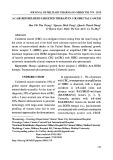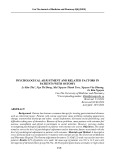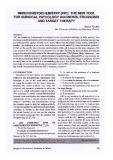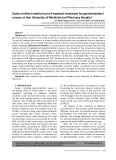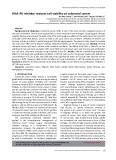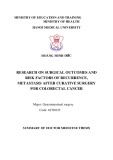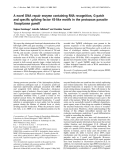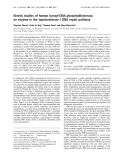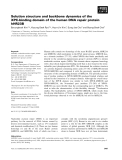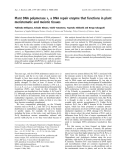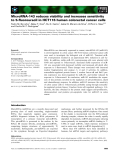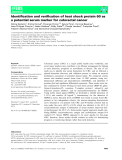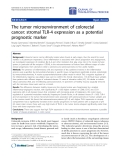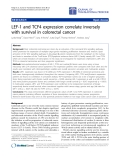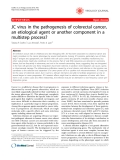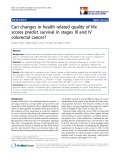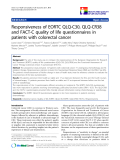
HUE JOURNAL OF MEDICINE AND PHARMACY ISSN 3030-4318; eISSN: 3030-4326 31
Hue Journal of Medicine and Pharmacy, Volume 14, No.4/2024
DNA-PK inhibitor reduces cell viability on colorectal cancer
Bui Khac Cuong1,2, Tran Phuong Linh1, *Nguyen Thi Mai Ly3*
( 1) Laboratory Animal Research Center, Vietnam Military Medical University
(2) Department of Pathophysiology, Vietnam Military Medical University
(3) Department of Biochemistry, Military Hospital 103, Vietnam Military Medical University
Abstract
Background and Objectives: Colorectal cancer (CRC) is one of the most common malignant cancers of
the colon worldwide. Several novel approaches to cancer treatment have emerged, including gene therapy,
targeted therapy, and adjuvant therapies. One of the most dangerous effects of chemotherapy is the induction
of double-strand DNA breaks, which can lead to cell cycle arrest and cell death. Inhibition of DNA-PK can
increase cellular sensitivity to radiotherapy and DNA-damaging agents. The present study aimed to evaluate
the anti-cancer effect of the DNA-PK inhibitor (DNA-PKi) NU7441 on the HCT116 cell line. Method: HCT116
colorectal cancer cells were cultured under standard conditions. The effects of NU7441, a DNA-PKi, on cell
viability and cell cycle were evaluated. WST-1 and FACS cell cycle assays were used to assess cell proliferation
and cell cycle. Data were analyzed using GraphPad Prism 8.4. Results: DNA-PKi showed dose-dependent
effects on cell death and proliferation inhibition in HCT116 cells in vitro. The groups treated with DNA-PKi at
concentrations of 0.125, 0.250, and 0.500 μM all had significantly lower cell survival rates than the control
group (p < 0.05). However, DNA-PKi did not affect cell cycle distribution in HCT116 colorectal cancer cells.
Conclusion: DNA-PKi NU7441 exerted a dose-dependent effect on cell death and proliferation inhibition in
HCT116 cells in vitro.
Keywords: colorectal cancer, DNA-PK, DNA repair, Double-strand DNA breaks, target therapy, non-
homologous end joining.
1. INTRODUCTION
Colorectal cancer (CRC) remains a formidable
global health challenge and ranks among the leading
causes of cancer-related morbidity and mortality.
Colorectal cancer (CRC) is a significant health burden.
Globally, it is the third most common cancer in males
and the second most common in females, ranking as
the third leading cause of cancer-related deaths [1].
Colorectal cancer is trending toward younger ages,
with cases as young as 15 to 18 years [1]. Data from
2018 in Vietnam showed that colorectal cancer ranked
fifth among the top 10 most common cancers in both
genders, with 14,733 new cases and 7,856 deaths. By
the year 2020, in Vietnam, the incidence of new cases
of colorectal cancer had risen to the fourth position
in males and the third position in females, with a new
incidence rate of 9%, totaling 16,426 cases [2].
The conventional treatment methods often
applied in the comprehensive management of
colorectal cancer include surgery, chemotherapy,
radiation therapy, or a combination of these
approaches. However, the prognosis of colorectal
cancer remains limited, with a 5-year survival rate of
less than 20% [3]. Depending on the condition and
progression of the disease, treatment methods can
be used in combination. For localized malignancies,
surgical removal of the entire colon tumor is often
an option, and any tumor location requires therapy.
However, not all cancer cells can be eradicated
entirely. Approximately 66% of patients with colon
cancer undergo additional adjuvant treatment
with chemotherapy and/or radiotherapy [4]. These
treatments have many side effects because they are
nonspecific and toxic to healthy cells. Additionally,
even after receiving adjuvant therapy, up to 54% of
patients relapsed [4]. Therefore, the development of
more effective alternative therapies to treat patients
with CRC is urgently needed.
Targeted therapy is a type of cancer treatment
that focuses on specific molecules involved in
the growth and survival of cancer cells. The goal
of targeted therapy is to block the growth and
spread of cancer cells while minimizing damage
to normal cells. DNA double-strand breaks (DSBs)
are considered the most deleterious form of DNA
damage. The DNA damage response (DDR) pathway
encompasses a collection of intricate mechanisms,
including DNA damage repair, DNA damage tolerance
mechanisms, and cell-cycle checkpoint control. This
intricate system governs the accurate execution of
DNA replication and proliferation and, subsequently,
cell viability. The DDR pathway plays a pivotal role in
Corresponding author: Nguyen Thi Mai Ly; Email: dr.nguyenmaily@gmail.com
Received: 20/4/2024; Accepted:18/6/2024; Published: 25/6/2024
DOI: 10.34071/jmp.2024.4.4





